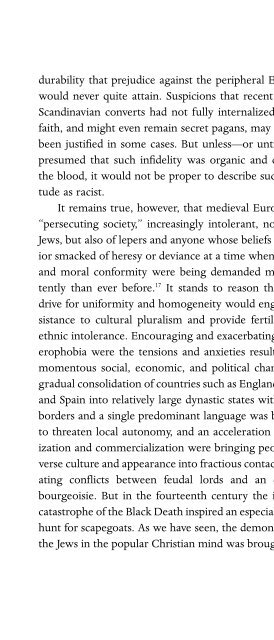Racism - A Short History - George M Fredrickson.pdf - WNLibrary
Racism - A Short History - George M Fredrickson.pdf - WNLibrary
Racism - A Short History - George M Fredrickson.pdf - WNLibrary
Create successful ePaper yourself
Turn your PDF publications into a flip-book with our unique Google optimized e-Paper software.
TWO The Rise of Modern <strong>Racism</strong>(s)<br />
seventeenth and eighteenth centuries created a standard<br />
from which Africans were bound to deviate. The Dutch<br />
sociologist Harry Hoetink has attributed to nations or ethnic<br />
groups “somatic norm images” or stereotypes of the<br />
beautiful that influence their attitudes toward people they<br />
perceive as physically different from themselves. 17 But these<br />
images are themselves cultural constructions that change<br />
over time. Because of the classical revival, Europeans of the<br />
seventeenth, eighteenth, and nineteenth centuries valued<br />
extreme paleness, as well as the facial features and physiques<br />
thought to have characterized the ancient Greeks<br />
and Romans.<br />
While critical to these aesthetic judgments about<br />
human types, skin color was not the be-all and end-all. The<br />
common admiration for the appearance of North American<br />
Indians was based on an appreciation of the physiques<br />
of young warriors. Before they became “redskins” in the<br />
late eighteenth century, their tawny complexions were either<br />
ignored or attributed to artifice rather than nature. 18<br />
On the other hand, the most denigrated of all races encountered<br />
by Europeans before the nineteenth century—the<br />
Khoikhoi or “Hottentots” of southern Africa—were not<br />
black or even dark brown but yellowish tan in pigmentation.<br />
They were viewed as the lowest of the low both because<br />
their nomadic, nonagricultural way of life was considered<br />
highly uncivilized and because in physique and<br />
physiognomy they were perceived as deviating more from<br />
the European somatic norm than did other (and much<br />
darker skinned) Africans. 19 What such reactions reveal is<br />
that the predominating belief in the unity of mankind and<br />
in the environmental sources of physical divergences<br />
60
















